Tolerance: < 100 km/h: 5 km/h, > 100 km/h: 5%
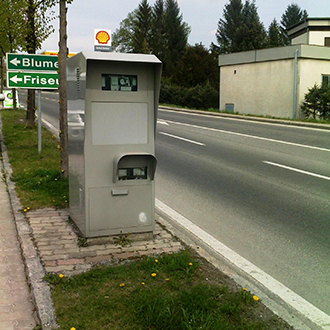
Technically these devices can take measurements and photos from the back as well as from the front. Which of these methods is used more frequently, depends on the country and sometimes even the county. Generally, most older devices measure from the back.
Anyway in both cases there can always be one measurement of one vehicle on one lane at a time. So, if multiple vehicles on multiple lanes pass this radar speed trap at a time, only one of them will get a ticket.
Good to know: Usually a measurement is marked invalid when a cars speed at the beginning and at the end of the measuring field has a difference bigger than 10%. So, if you slam the brakes hard exactly while the measurement is taken, you're
very likely to get away without a ticket, maybe even tough you're still too fast after breaking. How to protect your car.
Common models: Multanova 6F fixed, Multanova 6F mobile (Click to change picture)
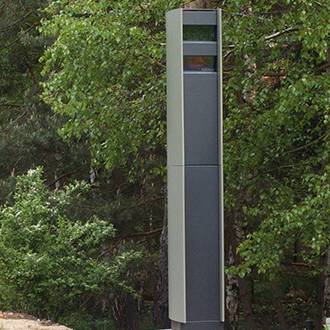
This method is almost identical to the ka-band radar, the main difference is that the signal uses another frequency. Depending on the country the k-band radar is in general not as popular as the ka-band radar. For protection against these speed traps
it is important to activate the k-band on your radar detector. Mostly, especially in urban and suburban areas this is definitely not recommended since a huge number of automatic garage- and shop doors as well as some traffic light sensors use the same
frequency and therefore lead to a massive amout of false warnings. How to protect your car.
Common models: Traffictower fixed, Siemens EMS fixed, Siemens EMS mobile (Click to change picture)
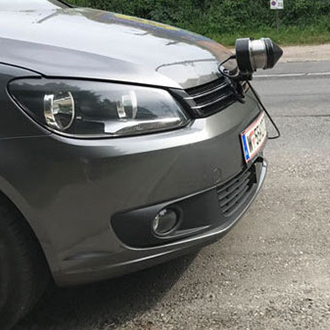
The functionality of mobile ka-band radars built into civil police cars is the same as in fixed traps. Important: some of these cars not only have a measuring unit built into the front, but in the back as well. This way both directions of a road can be
covered at the same time with a single vehicle - So if you see one of these cars but it's parked on the other side of the road we highly suggest to slow down anyway. The brands and models used vary from country to country, but in general mostly mini-vans.
Good to know: The vehicle with the radar speed trap in it has to be parked exactly parallel to the road with a given distance. If the vehicle is not parked correctly, the measurement is invalid. How to protect your car.
Common models: Multanova 6F in VW Touran, VW Sharan, Ford Galaxy (Click to change picture)
Tolerance: < 100 km/h: 3 km/h, > 100 km/h: 3%
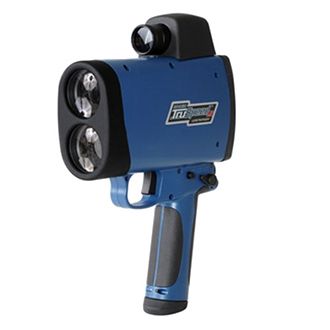
These devices are almost exclusively used to measure a car from the front because a photo proof can not be made and the officers have to either pull you over or at least write down your license plate number. Both of these options are
only possible when your speed is known before you pass the officer. From a technical point of view it is absolutely possible to take a measurement from the back, so don't speed up right after passing the police laser.
Good to know: The angle between your vehicle and the position of the officer measuring your speed must be relatively small. So, for example, if the officer is standing far away from the side of the street, this angle might be exceeded.
Also, measurements can only be taken on relatively straight roads, meaning that a measurement while driving in a tight curve might be invalid. How to protect your car.
Common models: LTI Truspeed, Riegel
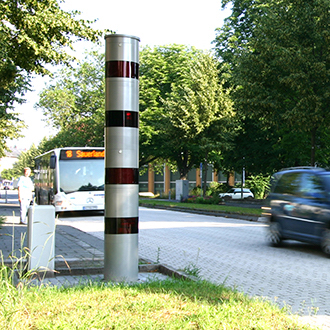
Looking like some kind of novel pillar, the Poliscan Speed tower works similar to a laser speed gun, but with one important difference. Unlike a usual police laser, this system is not only sending laser pulses when a specific vehicle is targeted,
but instead all the time. Even multiple lanes can be monitored at the same time by moving the laser from side to side all the time really fast and tracking every single vehicle within the area beginning about 70 meters in front of the tower.
By tracking you until you pass the device, your average speed in this section of known distance can be calculated. Attention: The Poliscan Speed tower can not only monitor multiple lanes at the same time, but also both sides of multidirectional roads
in fact, up to 8 lanes (4 in each direction) are monitored simultaneously. Exception: Smaller models that look identical, but have only two instead of four black rings around the grey pillar. They can only monitor one direction, but still with multiple lanes. How to protect your car.
Common models: Vitronic PoliScan Speed
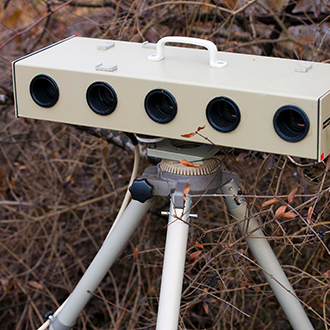
Ordinary laser jammers are useless here. Since the laser pulses are not directed to your car from the front but from the side, you will need special laser jammers facing sidewards to protect yourself against this system. The idea behind it is simple:
The first, second and fifth dot on the device each send their own laser beam across the road in a 90 degree angle. When passing the ESO, you interrupt each beam, one after another. By taking the time between these interruptions and with the known distance
between the beams, your speed is calculated. The second and fourth dot on the device measure the distance from the side of the road to your car, making it possible to monitor multiple lanes since it now knows which lane you are on. How to protect your car.
Common models: ESO 3.0
Tolerance: depends, but at least 3 km/h
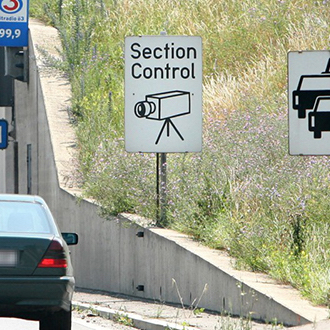
On a section control your car is photographed at the beginning of a defined section of the road, usually a few kilometers long. At the end of the section another photo is taken. Automatically reading your license plate your two photos are matched to
determine the time between them. Knowing distance and the time it took you to travel it, your speed can be determined.
Important: Effective protection is only possible by always having the newest software versions and GPS databases installed on your radar detector.
Good to know: In many countries section controls must be marked the beginning as well as at the end by a sign.
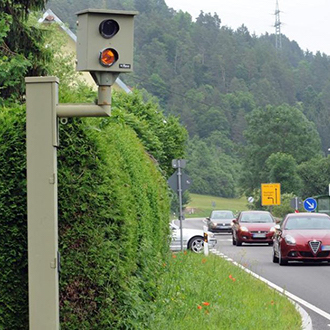
Similar to the section control, the time you need to travel from one point to another is taken. The difference: taking the time is not done trough phots but with induction loops in the ground which are unlike on a section control not some kilometers but only a few meters apart. Each induction loop produces a magnetic field which is disturbed by your vehicle when passing the loop. Knowing the distance between the two loops and the time you needed to travel this distance, your speed is calculated. Photos are usually taken from the front. Important: Effective protection is only possible by always having the newest software versions and GPS databases installed on your radar detector.
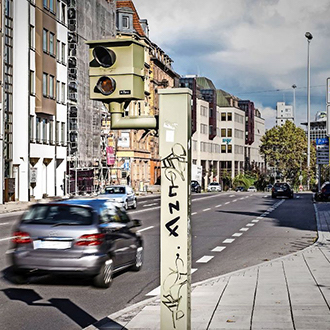
By using induction loops, the system knows that you passed a certain point on the street. If this happens while the traffic light was red (the system is connected to the traffic light), you will get caught. Photos are usually taken from the front here. Important: Effective protection is only possible by always having the newest software versions and GPS databases installed on your radar detector.